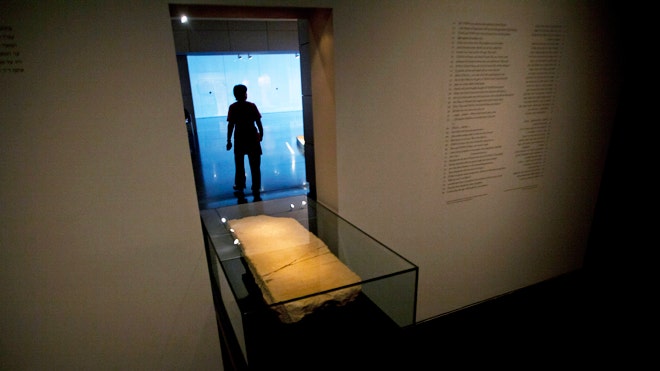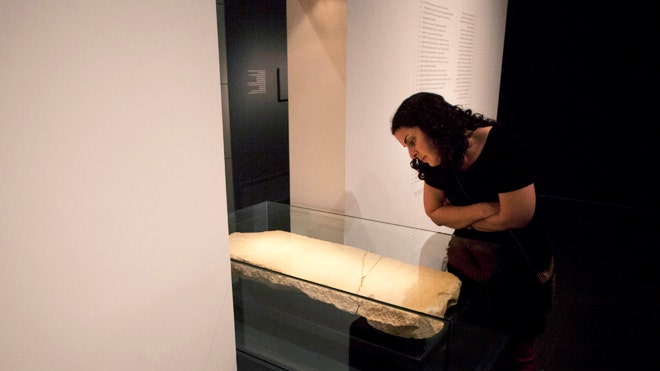JERUSALEM – An
ancient limestone tablet covered with a mysterious
Hebrew text that features the archangel Gabriel is
at the center of a new exhibit in Jerusalem, even
as scholars continue to argue about what it means.
The
so-called Gabriel Stone, a meter (three-foot)-tall
tablet said to have been found 13 years ago on the
banks of the Dead Sea, features 87 lines of an
unknown prophetic text dated as early as the first
century BC, at the time of the Second Jewish
Temple.
'The Gabriel Stone is in a way a Dead Sea Scroll written on stone.'
-
James Snyder, director of the Israel Museum
Scholars
see it as a portal into the religious ideas
circulating in the Holy Land in the era when was
Jesus was born. Its form is also unique -- it is
ink written on stone, not carved -- and no other
such religious text has been found in the region.
Curators
at the Israel Museum, where the first exhibit
dedicated to the stone is opening Wednesday, say
it is the most important document found in the
area since the discovery of the Dead Sea Scrolls.
"The
Gabriel Stone is in a way a Dead Sea Scroll
written on stone," said James Snyder, director of
the Israel Museum. The writing dates to the same
period, and uses the same tidy calligraphic Hebrew
script, as some of the Dead Sea Scrolls, a
collection of documents that include the earliest
known surviving manuscripts of Hebrew Bible texts.
The
Gabriel Stone made a splash in 2008 when Israeli
Bible scholar Israel Knohl offered a daring theory
that the stone's faded writing would revolutionize
the understanding of early Christianity, claiming
it included a concept of messianic resurrection
that predated Jesus. He based his theory on one
hazy line, translating it as "in three days you
shall live."
His
interpretation caused a storm in the world of
Bible studies, with scholars convening at an
international conference the following year to
debate readings of the text, and a National
Geographic documentary crew featuring his theory.
An American team of experts using high resolution
scanning technologies tried -- but failed -- to
detect more of the faded writing.
Knohl,
a professor of Bible at Hebrew University in
Jerusalem, eventually scaled back from his
original bombshell theory but the fierce scholarly
debate he sparked continued to reverberate across
the academic world, bringing international
attention to the stone. Over the last few years it
went on display alongside other Bible-era
antiquities in Rome, Houston and Dallas.
Bible
experts are still debating the writing's meaning,
largely because much of the ink has eroded in
crucial spots in the passage and the tablet has
two diagonal cracks the slice the text into three
pieces. Museum curators say only 40 percent of the
87 lines are legible, many of those only barely.
The interpretation of the text featured in the
Israel Museum's exhibit is just one of five
readings put forth by scholars.
All
agree that the passage describes an apocalyptic
vision of an attack on Jerusalem in which God
appears with angels on chariots to save the city.
The central angelic character is Gabriel, the
first angel to appear in the Hebrew Bible. "I am
Gabriel," the writing declares.
The
stone inscription is one of the oldest passages
featuring the archangel, and represents an
"explosion of angels in Second Temple Judaism," at
a time of great spiritual angst for Jews in
Jerusalem looking for divine connection, said
Adolfo Roitman, a curator of the exhibit.
The
exhibit traces the development of the archangel
Gabriel in the three monotheistic religions,
displaying a Dead Sea Scroll fragment which
mentions the angel's name; the 13th century
Damascus Codex, one of the oldest illustrated
manuscripts of the complete Hebrew Bible; a 10th
century New Testament manuscript from Brittany, in
which Gabriel predicts the birth of John the
Baptist and appears to the Virgin Mary; and an
Iranian Quran manuscript dated to the 15th or 16th
century, in which the angel, called Jibril in
Arabic, reveals the word of God to the prophet
Mohammad.
"Gabriel
is not archaeology. He is still relevant for
millions of people on earth who believe that
angels are heavenly beings on earth," said
Roitman. The Gabriel Stone, he said, is "the
starting point of an ongoing tradition that still
is relevant today."
The
story of how the stone was discovered is just as
murky as its meaning. A Bedouin man is said to
have found it in Jordan on the eastern banks of
the Dead Sea around the year 2000, Knohl said. An
Israeli university professor later examined a
piece of earth stuck to the stone and found a
composition of minerals only found in that region
of the Dead Sea.
The
stone eventually made it into the hands of Ghassan
Rihani, a Jordanian antiquities dealer based in
Jordan and London, who in turn sold the stone to
Swiss-Israeli collector David Jeselsohn in Zurich
for an unspecified amount. Rihani has since died.
The Bible scholar traveled to Jordan multiple
times to look for more potential stones, but was
unable to find the stone's original location.
Israel
Museum curators said Jeselsohn lent the stone to
the museum for temporary display.
Lenny
Wolfe, an antiquities dealer in Jerusalem, said
that before the Jordanian dealer bought it,
another middleman faxed him an image of the stone
and offered it for sale.
"The
fax didn't come out clearly. I had no idea what it
was," said Wolfe, who passed on the offer. It was
"one of my biggest misses," Wolfe said.
What
function the stone had, where it was displayed,
and why it was written are unknown, said curators
of the Israel Museum exhibit.
"There
is still so much that is unclear," said Michal
Dayagi-Mendels, a curator of the exhibit.
Scholars, she said, "will still argue about this
for years."


